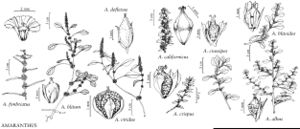Amaranthus crispus
in A. Gray et al., Manual ed. 6, 428. 1890.
Plants annual, sparsely pubescent. Stems prostrate to ascending, branched mainly from base, 0.1–0.4 (–0.5) m. Leaves: petiole shorter than blade; blade rhombic-ovate to oblong, 0.5–1.5 (–2.5) × 0.3–0.8 (–1.5) cm, base cuneate, margins crisped-erose, conspicuously undulate, apex acute to subobtuse, with short mucro. Inflorescences axillary glomerules, green, axes not thickened, not indurage at maturity. Bracts lanceolate to oblong-lanceolate, 1.2–1.7 mm, ± equaling or slightly shorter than tepals. Pistillate flowers: tepals 5, spatulate-oblong, equal to subequal, 1.2–1.7 mm, margins entire, apex rounded to subacute; style-branches spreading; stigmas 3, sessile. Staminate flowers intermixed with pistillate; tepals 5; stamens 5. Utricles ellipsoid or obovoid, 1.5–2 mm, slightly longer than tepals, smooth to slightly wrinkled, indehiscent. Seeds black to dark reddish-brown, lenticular to obovoid-lenticular, 0.7–1 mm diam., smooth.
Phenology: Flowering summer–fall.
Habitat: Waste places, other disturbed habitats, mostly at seaports and on ballast
Elevation: 0-500 m
Distribution
Introduced; N.J., N.Y., N.C., Va., native to South America (Argentina), in s Eurasia and other regions
Discussion
Selected References
None.
